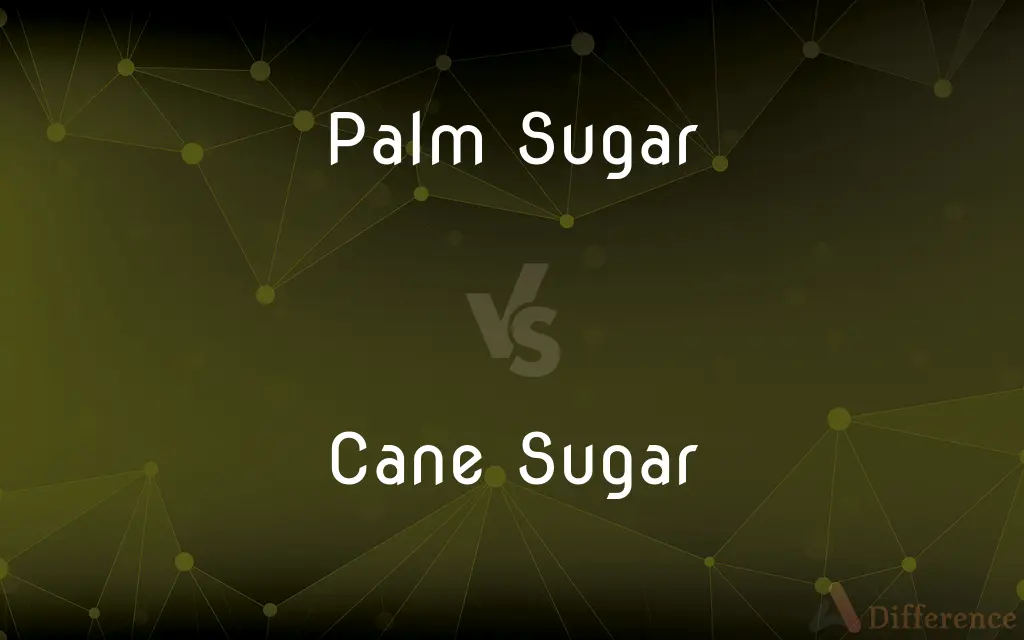Palm Sugar vs. Cane Sugar — What's the Difference?
Edited by Tayyaba Rehman — By Maham Liaqat — Published on March 2, 2024
Palm Sugar, derived from the sap of various palm trees, offers a complex flavor with hints of caramel, while Cane Sugar, extracted from sugarcane, is known for its sweet, neutral taste and is widely used as a standard sweetener.

Difference Between Palm Sugar and Cane Sugar
Table of Contents
ADVERTISEMENT
Key Differences
Palm Sugar and Cane Sugar are two natural sweeteners that come from different plant sources and have distinct flavors, nutritional profiles, and uses in cooking and baking. Palm Sugar is produced from the sap of various types of palm trees, including coconut, date, and sago palms. This sugar is less processed compared to cane sugar, retaining more of its natural nutrients, including minerals like potassium, magnesium, and zinc. It has a rich, caramel-like taste, making it a favored ingredient in many Southeast Asian dishes for both its flavor and nutritional benefits.
Cane Sugar, on the other hand, comes from the sugarcane plant. It undergoes several processing steps to produce the granulated white sugar commonly found in households. This processing strips away most of the molasses content and, with it, much of the sugar’s nutritional value, resulting in a product that is almost pure sucrose. Its neutral sweet taste makes it extremely versatile, used widely in beverages, baked goods, and as a general-purpose sweetener.
One of the main differences between these sugars lies in their glycemic index (GI), which measures how quickly foods raise sugar levels. Palm Sugar has a lower GI compared to Cane Sugar, making it a potentially better option for maintaining stable sugar levels. However, this can vary depending on the type of palm sugar and its processing method.
The sustainability aspect also differentiates them. Palm Sugar production is considered more environmentally friendly and sustainable, as it comes from trees that can produce sap for decades without the need for intensive farming practices. Cane Sugar farming, conversely, has been criticized for its environmental impact, including land use changes and the use of large amounts of water.
In culinary applications, the unique flavor of Palm Sugar is prized in traditional dishes, sauces, and desserts in Southeast Asian cuisine. Cane Sugar, with its neutral profile, is a staple in Western baking and cooking, serving as the baseline sweetener against which others are compared.
ADVERTISEMENT
Comparison Chart
Source
Sap of palm trees (e.g., coconut, date palms)
Sugarcane
Flavor
Rich, caramel-like
Sweet, neutral
Nutritional Value
Higher mineral content, lower GI
Mostly sucrose, higher GI
Environmental Impact
Generally sustainable, less water-intensive
Can be high, depending on farming practices
Culinary Uses
Southeast Asian dishes, desserts
Versatile, used in baking and as a general sweetener
Compare with Definitions
Palm Sugar
It comes from the sap of palm trees, making it rich in minerals.
Palm Sugar is often touted for its nutritional benefits in traditional diets.
Cane Sugar
It undergoes extensive processing to achieve a neutral taste.
The refining process of Cane Sugar ensures its versatility in culinary uses.
Palm Sugar
Palm Sugar is versatile in cooking, especially in Southeast Asian cuisine.
It's a key ingredient in Indonesian and Thai dishes for its unique taste.
Cane Sugar
Cane Sugar is extracted from sugarcane and is known for its pure sweetness.
Cane Sugar is the most common sweetener in baking recipes.
Palm Sugar
Palm Sugar is a natural sweetener with a rich, caramel flavor.
Palm Sugar enhances the taste of Thai curry with its deep flavor.
Cane Sugar
Cane Sugar is a staple ingredient in global cuisine, used for its consistent sweetness.
From cakes to beverages, Cane Sugar is ubiquitous in recipes worldwide.
Palm Sugar
Palm Sugar has a lower glycemic index, suitable for more stable blood sugar.
Using Palm Sugar in recipes can be a healthier option for those monitoring sugar levels.
Cane Sugar
Cane Sugar has a higher glycemic index, affecting sugar levels more significantly.
Consuming foods high in Cane Sugar can lead to spikes in blood sugar.
Palm Sugar
It's considered environmentally sustainable.
Palm Sugar production supports traditional farming methods.
Cane Sugar
Its production can have considerable environmental impacts.
Large-scale sugarcane cultivation has been linked to deforestation.
Common Curiosities
Which is healthier, Palm Sugar or Cane Sugar?
Palm Sugar is considered healthier due to its lower glycemic index and higher mineral content, but moderation is key with any sweetener.
How does the glycemic index of Palm Sugar compare to Cane Sugar?
Palm Sugar typically has a lower glycemic index than Cane Sugar, meaning it raises sugar levels more slowly.
Is Palm Sugar always better for the environment?
Generally, yes, due to less intensive farming practices, but the sustainability can vary depending on the source and production methods.
Can diabetics consume Palm Sugar?
Palm Sugar may be a slightly better option due to its lower GI, but diabetics should still consume it sparingly and monitor their sugar levels closely.
Can Palm Sugar be substituted for Cane Sugar in recipes?
Yes, but it may alter the flavor profile due to its caramel-like taste. The substitution often requires experimentation to achieve the desired sweetness.
Are there any ethical concerns with Palm Sugar production?
While generally considered sustainable, it's important to source Palm Sugar from producers that follow ethical practices and support local communities.
How should Palm Sugar and Cane Sugar be stored?
Both should be stored in airtight containers to prevent moisture absorption. Palm Sugar can harden over time and may need to be softened before use.
Can I use Cane Sugar in Asian dishes instead of Palm Sugar?
Yes, but it may not replicate the authentic taste that Palm Sugar provides to traditional Asian dishes.
Are there color differences in the final product when substituting Palm Sugar for Cane Sugar?
Yes, Palm Sugar can impart a darker color to foods due to its natural color, which may affect the appearance of some dishes.
Does Cane Sugar always cause environmental harm?
Not always, but its environmental impact can be significant without sustainable farming practices. Look for sustainably sourced options.
What are the main uses of Palm Sugar and Cane Sugar?
Palm Sugar is used in traditional Southeast Asian dishes and desserts for its unique flavor, while Cane Sugar is versatile, used widely in baking and as a general sweetener.
Can the use of Palm Sugar and Cane Sugar affect the texture of baked goods?
Yes, since Palm Sugar often comes in a paste or granulated form, it can affect moisture content and texture in recipes designed for Cane Sugar.
Is there a taste difference between Palm Sugar and Cane Sugar?
Yes, Palm Sugar has a complex, caramel-like flavor, while Cane Sugar is purely sweet with a neutral taste.
How can consumers ensure they are purchasing sustainably sourced Palm or Cane Sugar?
Look for certifications such as organic, Fair Trade, or Rainforest Alliance, which indicate sustainable and ethical production practices.
Is Palm Sugar more expensive than Cane Sugar?
Typically, yes, due to its artisanal production process and nutritional benefits, Palm Sugar can be more costly than Cane Sugar.
Share Your Discovery

Previous Comparison
Kobo Sage vs. Kobo Libra 2
Next Comparison
Black Widow vs. Red Back SpiderAuthor Spotlight
Written by
Maham LiaqatEdited by
Tayyaba RehmanTayyaba Rehman is a distinguished writer, currently serving as a primary contributor to askdifference.com. As a researcher in semantics and etymology, Tayyaba's passion for the complexity of languages and their distinctions has found a perfect home on the platform. Tayyaba delves into the intricacies of language, distinguishing between commonly confused words and phrases, thereby providing clarity for readers worldwide.












































